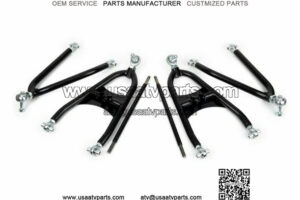When designing a long arm suspension system there is always one massive issue: the engine is in the way. Ideally, you want the mounting points right next to each other to maximum A-arm length. The only way to really achieve this is to pretty much shove the engine all the back into the cab. On a street
On a street driven prerunner pushing the engine into the cab is simply not an option. So, how do you maximum suspension travel without moving the engine? A J-Arm suspension might be your solution, so let’s take a look at how it all works.
A-Arm Suspension:
With a standard A-arm suspension, the upper and lower arms are in the shape of an “A”. This shape allows the shock or coilover to run between the suspension mounting points. Each arm has two mounting points on the chassis and one mounting point for the spindle. In the case of
In the case of streetcars, you might hear this be called “dual-wishbone”. This design is really great up until you need the longest arms possible to increase travel.
J-Arm Suspension:
With a J-arm suspension, the lower arm retains the “A” shape, but the upper arm is the shape of a “J”. This shape puts both suspension mounting points further forwards on the chassis, and the coil-over runs behind the upper arm instead of through it. Putting the suspension points further forwards on the chassis allows for them to be further in the chassis without moving the engine.
However, this design is not perfect. Putting both suspension mounting points in front of the coilover creates massive stress. This means the mounting points need to be extremely strong, as does the frame and the other suspension components.
The arm itself may even need to be extra thick to hold up to the stress. This can ultimately add more weight to the vehicle, and possibly more unsprung weight which is never good.
Who Uses J-Arm Suspension?
Some ATVs and UTVs use the J-arm design. It allows for larger diameter coilovers which are stronger and cool better. Since ATVs and UTVs are significantly lighter than trucks the stress that the suspension receives is much less. Also since there isn’t an engine in the front it’s not even necessary to have J-arm unless you want massive coilovers.
It is not as common to see a J-arm kit in the wild. Since you’re modifying the factory arm mounting location there isn’t really a “bolt-on” J-arm kit. The whole thing has to be custom made which is a very expensive and lengthy process.
Since the J-arm kit requires extra strong mounting locations, the frame will also need to be strengthened which opens another can of worms. You could just run a shorter upper A-Arm than you’d like and deal with the more aggressively camber curve, but that’ll really depend on the type of racing you’re doing.
Summary
Quite honestly unless you’re willing to throw a bunch of money at your truck it’s really not worth switching to J-arm. An A-arm suspension setup is going to be cheaper, stronger, and will have nearly as much travel as a J-arm setup.
About ATV A-Arm
“atv a arm guards”
“atv a arm bushings”
“atv a arm kit”
“atv a arm bushing removal”


